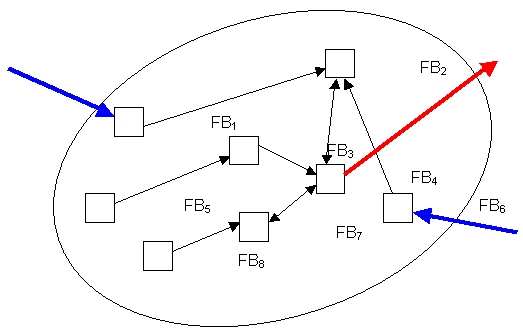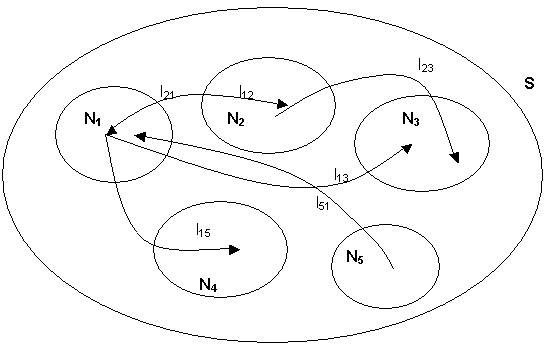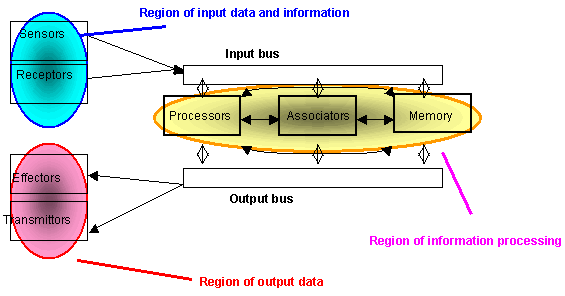Reliability and homogenisation of heterogenous systems
Prof. Ing. Votruba Zdeněk
Multiconference Circuits, Systems, Communication and Computers, Crete, July 8-15, 2001
Summary:
The concept of translation-ability is introduced with regard to reliability and safety of translation operations, which needs to be realized in any heterogeneous system.
The main kinds of possible sources of translation faults are discussed and some non-conventional ways for translation reliability improvement are proposed. A special attention is given in this respect to information systems as one of most important kind of systems at all.
As far as it is known, all real systems are of the heterogeneous nature in principle. They consists of certain number N (often quite large) of partial functional blocks FBi, each of them realizes a set of system partial block functions Fi.
All the N functional blocks, involved in the system under consideration are organized with respect to some system structure St.
Individual blocks and their sets of corresponding block functions can be quite different in general, of course some of them can be also identical.
However, for to be able to produce the required set of system functions F, each heterogeneous system has to be homogenized in such a manner, that:
* its external properties have to be of certain identity,
* its internal structure St has to involve certain number of interfaces IF ensuring the necessary interactions among all the partial functional blocks, from which the system under consideration consists.
The interfaces ensure the proper translation of information exchanged among the partial functional blocks, participating on the system activity.
The axiom can be formulated:
Each system, natural or artificial, without respect to its physical nature, must use its own information subsystem (or at least to share the use of activity of the information subsystem belonging to some other system).
Without proper activity of such information subsystem any real system cannot operate well, or even more, it cannot operate at all.
The artificial information systems are of special importance to our study, especially for their significance in novel transportation applications.
Contemporary artificial information systems are characteristic with their still increasing complexity and importance. They realize various complex and complicated system functions, very often of very high economic, business, social (political) and strategic value. Therefore, the operation of such artificial information system must be performed with high level of functional efficiency and reliability.
Suppose that the information system under consideration realizes a set F = {Fk} , k - 1…K of system functions.
Of course, not all the partial system functions Fk of such an information system are of the same importance.
Therefore, the importance of each Fk can be measured by some value of importance merit IMk = <0,1>. After the estimation of the values of IMk is made, one can concentrate on the most significant of them (suppose that the corresponding system functions are denoted as FkIm).
Suppose further, that the set F depends on:
* the structure St of the information system,
* the vector X of N system parameters xi, n = 1…N
* the vector P of J independent variables pj, j = 1…J
The further assumption can be made because of simplicity:
* the structure St of the system does not change with independent variables;
* all the system parameters xi can be expressed by real numbers;
* from all possible independent variables pj the time pj = t is considered as most important, because for any real system it acts as the only absolute uninfluenced independent variable.
This assumption is very often fulfilled with high accuracy. Nevertheless, if no, the respective modification of the further observations can be made without problems.
Among particular FBs in certain system the exchange of information is performed (see Fig. 1).

Fig. 1: System S consisting of 8 FBi in mutual information interaction. Blue arrows represent the information input from external world, red arrow is the information output to external world.
Functional blocks FB acting in general systems can be of various kinds, however for information systems the following kinds can be considered as typical:
* receptors,
* processors,
* associators,
* memory,
* effectors.
Among the all these main kinds of functional blocks various feed-forward and feed-back interactions exist. Because many of these basic functional blocks can in a real information system appear to be operating in parallel, these interactions exist also among the individual functional blocks of all the mentioned kinds and the structure St of real information system can be therefore very often much more complicated.
Suppose now the heterogeneous system S consisting of the network of N partial sub-networks Ni, i = 1…n. Each of them has different internal structure Si and operates with a set of parameters Xi = {xij}, where j = 1,…Ji is the number of parameters representing partial sub-network Ni. All these sub-networks realize some sets of system functions Fik, k = 1,…Ki. Some of sub-networks Ni interact with others sub-networks (see the symbolic example in Fig. 2).

Fig. 2: To the concept of sub-networks and mutual interaction among them.
Suppose, without restriction on generality, that none of sub-networks Ni is isolated. The direction of interactions and the strength among sub-networks is expressed by a set of interaction functions Ii. They transform the set of output parameters Xo i (transport mediums, signals, etc.) acting on the output ports of the sub-network Ni to the input ports of the particular sub-network, which with sub-network Ni interact. Like in all the respective sub-networks, also among them the informations are exchanged. On the reliability of this exchange the functional ability of the whole system is dependent.
Let now consider the situation of the transmitting object. Here the following significant situations can appear:
* The data are broadcasted around without the respect how the receivers interpret them. The reliability of information transmission is not ensured in such case.
* The broadcasted data are systematically modified so that one group of receivers interpret them in different manner than the other group
* The data are transmitted to the particular receiver by two or more different distributors. In such case at this receiver the interaction among data obtained from two or more sources can appear and the interpretation of resulting information can be quite different from that what was originally transmitted.
From the structural point of view all the information subsystems must involve the part oriented to sensoring, signal reception, signal processing, memory, associations, effectors and transmission (see Fig 3.).
Among all these parts exist various couplings, which can be quite complex and complicated, involving the whole set of feed-forward and feed-back parts. These couplings require the information transmission, which is realized via the respective interfaces.

Fig. 3: To the general structure of information sub-system.
Each of participating ISS interprets the received data in at least different manner, with respect to its own properties and needs. More over, it reflects also different kinds of transformation of this information to output data which will be used for influencing of other ISS interacting and co-operating with the particular one. All the input and output data like the internal information of the particular ISS can be interpreted in different alphabets. This fact is extremely important because it causes the necessity to take into account also the concept of ability of translation and of its efficiency and reliability. This we shall understand under the term of translation-ability.
Each of participating ISS interprets the received data in at least different manner, with respect to its own properties and needs. More over, it reflects also different kinds of transformation of this information to output data which will be used for influencing of other ISS interacting and co-operating with the particular one.
All the input and output data like the internal information of the particular ISS can be interpreted in different alphabets. This fact is extremely important because it causes the necessity to take into account also the concept of ability of translation and of its efficiency and reliability. This we shall understand under the term of translation-ability.
Let us try to express the concept of translation-ability as:
the ability of efficient multi-language translation, or at least non-zero intersection among two subsets, or the derivative rules, defining the relations between two alphabets (or sub-alphabets of some alphabet).
The concept of translation reliability.
By reliability we understand in general the probability that some activity will we be able to realize or that some procedure will exists.
The procedure of translation between two different multi-languages consists in its development in space and time. The process of translation can be realized in more parallel branches and its final stage is therefore fixed the course of comparison of obtained interactions of two or more alternatives of translation under certain optimization strategy. From this the final form and stage of translation results.
Of course, in these translation operations various errors, imperfections and faults appear. Such problems appear also in other parts of the information processing procedure, especially in the transmission of information, saving information into storage, mining the particular information out form the storage, mining the hidden information, exploiting the obtained information.
In all these cases the methodical apparatus of the general theory of system reliability can be applied, of course one cannot exclude that in certain particular cases some specific conditions and rules must be respected.
The improvement of interface operation reliability, i.e. of its ability to translate the respective information properly is therefore of great interest.
There are known four possible ways how to reach this goal:
* to make the interface as most robust as possible,
* to duplicate or multiplicate the respective interface,
* to minimize the sensitivity of the respective interface function to the changes of its parameters,
* to incorporate into the respective interface a special part providing the prediction of its functions deviation from requested values and ensuring the subsequent correction of corresponding parameters.
All of these approaches have some advantages and disadvantages.
The first two requires usually more economic effort; the third one is usually applicable when designing the new interface.
The last one can be considered as most sophisticated and requires the storing of the main data representing the interface function history, their deep analysis, mining of the hidden correlations, finding of the most important interface parameters by the change of which the interface function can be influenced, development of the respective predictors and the necessary correction feedback loops. Of course, such prediction diagnostics can be applied not only on the respective interface operation itself, but also on the content of the input information. In some cases this can be distorted by various influences and the restoration if it before the translation can improve the reliability of the respective translation procedure. In similar manner also the problems of information coding and decoding for safe information transmission among the cooperating partial functional blocks have to be mentioned.